
 |
Quadrupedal Hominid Galloping is included in tonight's Emergent Ecologies film screening at Kilroy, 283 Greene Ave, Brooklyn. 8-10pm.
Much thanks to Ally Roth for her cinematography, camera operation and location scouting.
“We are made of star stuff,” is Carl Sagan's lasting insight, the take-away line from his landmark television series, Cosmos. His 13 episode cosmological tour-de-force presents thrilling evidence that even our simplest, most private actions and dreams can be best understood when placed in a context of the entirety of being.
A few days ago, by seeming happenstance, I came across composer John Boswell's ingenious tribute to the late astronomer: "A Glorious Dawn.” Having just completed my edit of the 16 month process video that accompanies the latest oil on canvas, Joan Of Arc Riding My Little Pony, I played the composition along with the finished clip.
The uncanny congruence of the two was striking – a match made in the heavens. As if evidencing an awesome super-structure in operation, could the structure at play be the structure of play? Shine on, fellow star stuff!
A few other painting gems culled from YouTube:
• Robert Rauschenberg speaks of erasing De Kooning.
• Clip from Hans Namuth’s 1951 film of Jackson Pollock painting – I love Pollock’s celebrated, definitive voice-over, a de facto national treasure!
• Another few seconds from inside Pollock’s barn.
• Trailer of The Mystery Of Picasso (1956).
• Cope 2: Old School graffiti master.
• Jean-Michel Basquiat painting from Downtown 81.
• Rinpa Eshidan offers painting as performance.
• Salvador Dali on What’s My Line – incredibly engaging!
Managing the potentially disabling demands of focus and invention that confront every artist who stands before a boundless canvas is key. It’s been my experience that there is a deep desire on the part of the painter - maybe even a necessity - to arrive at some strategic armature or limiting structure within which to act. After all, as Georges Braque said of the sustained inspiration intrinsic to the demands of Fauvism, “You can’t remain forever in a state of paroxysm.”
Many of the liberating restrictions painters have come upon are formal - think Agnes Martin. During this Grand Canyon commission, the resolution of Burro Train delivered a formal armature. But the unspoken collaboration with the client who commissioned the project awoke me to a liberating restriction of another sort: service.
During the course of painting the first Grand Canyon canvas, I registered each moment of acute delight on the part of the client and realized this client was consistent and yet loved having preconceptions eclipsed.
Whether to the painting, a client or the ground beneath our feet, service proves to be self-serving.
Thus, this service to another’s vision laid the foundational “liberating restriction” to a new process and a second canvas in the commission, Canyon Ascent. This phantom restriction most tangibly manifests in an enhanced naturalistic depiction of depth. Maintaining its predecessor's assertive frontality in the advancing picture plane, Canyon Ascent incorporates the client’s desired depiction of depth. (So, its completed surface operates like a subtler version of the telescoping dolly zoom famously used by Hitchcock.)
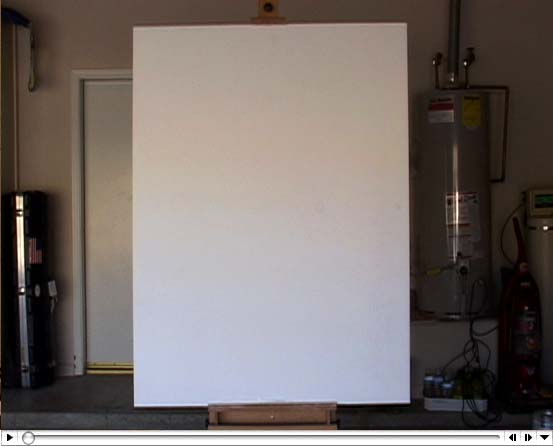
To see the process, click the image above for the hi-res QT movie (1 min., 7.3Mb) or try the YouTube version.
When I first began this assignment - painting an “abstract” Grand Canyon - my initial foothold was the realization that I didn’t have to conceive or execute a vision so much as embody processes congruent to those which formed the Canyon, itself. Geomimicry as painting strategy: The accumulation of sediment (or paint) and the process of erosion that resurfaces that accumulation reveals its unique logic and corresponding beauty.
This created a particularly satisfying development of illusionistic depth and naturalistic proportions. In the same way that the Canyon represents a cleaving through geologic history, Canyon Ascent embodies a scraping through layers of art history.
Its fidelity to the abstractions of geomimicry and service make this painting read as representational. This resolution afforded me the rare experience of physically unearthing the academically observed substratum that undergirds America’s Abstract Expressionists: The Romantic Hudson River School painters - Cole, Kensett, Gifford, Bierstadt, Church.
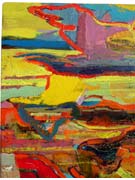 |
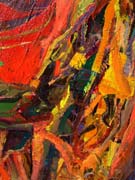 |
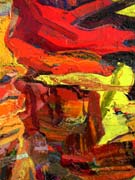 |
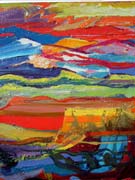 |
 |
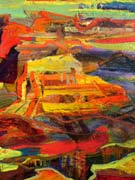 |
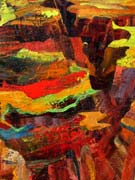 |
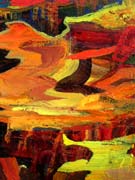 |
For a "Special Features" insight into this post click for further commentary.
Being incomprehensible to quotidian existence, the Grand Canyon presents an uncommonly great subject for a painting.
This sentiment did not originate with me - recently, it was re-introduced by a client who, enthused by the emergence of landscape in my Mountain Paintings, was curious to see what would be my abstract response to the Grand Canyon.
So began a two month encampment in Arizona where, under the sun, in unspoken collaboration with my client, I was an object of bemusement and intrigue to a gated-community in Scottsdale. In this atmosphere, I got my mind around the project while developing a vocabulary at breakneck speed.
Amazingly - and, perhaps, fortuitously - I’d embarked on the project with no previous firsthand experience of the Grand Canyon. Sedona - which one experiences as a landscape of protuberances, not a canyon - was the furthest north I’d ever travelled in Arizona. (Note: you can see the “before and after” transformation in the painting’s video where the canvas shifts from the Sonoran Valley of the Sun to take on the depth and breadth so aptly noted in the name, Grand Canyon).
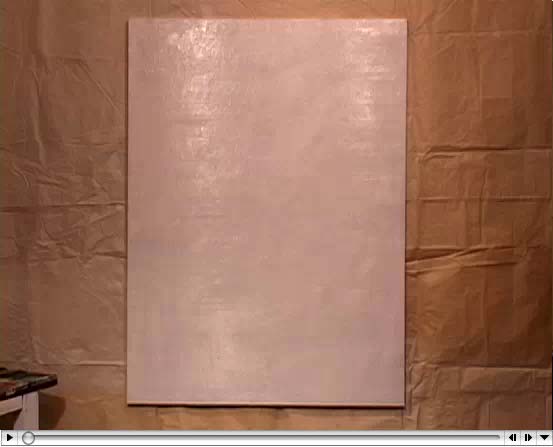
To see the process: Click the image above for the hi-res QT movie (1 min., 6.6Mb) or try the YouTube version.
Upon arriving at the Canyon, I was guided to the rim with my eyes shut. My hosts positioned me so that my first glimpse would be unobstructed and immediate. Opening my eyes, my first impression was that the scene appeared flat - like a cinematic backdrop. The sense of scale was unintelligible. The shadows in the distance read as positive shapes - having more solidity than the rock. The drama was that of alternating intervals of sun and shadow dappling across the unfathomable expanse.
From the rim, especially in the bleaching midday sun, this grand panorama registers as an uncannily and solely retinal experience; Walking into it does not feel like an option.
All this, I wanted in the painting.
Plainly, though, I was going to have to get physically into the landscape. The South Kaibab Trail obliged. Upon going over the rim, the Canyon instantly becomes a participatory event - hiking, an act of sculpting - each step down raises the horizon up. This I wanted to get into the painting, too.
It is a fascinating irony that two-dimensional, pictorial depiction dictates a correspondence between moving down into the canyon and moving up the canvas. This became an experiential dynamic of the painting. As a point of reference, I remembered the Met’s Joachim Patinir painting, The Penitence of Saint Jerome, whose gallery wall label reads, in part:
“The true subject of the picture, however, is Patinir's splendid panoramic landscape, which the viewer is encouraged to travel through visually in the manner of a pilgrimage.”
Hence, the incorporation of the burro train whose members are (pun intended) burrowing their way ever deeper into the canyon while correspondingly ascending the canvas in a pilgrimage of step-by-step transcendence that's all in a day's work.
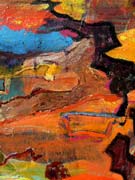 |
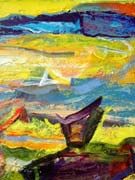 |
 |
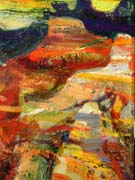 |
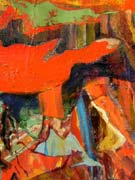 |
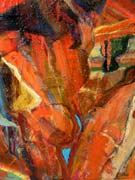 |
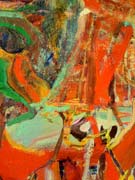 |
 |
Burro Train is still available for purchase. Why, you might ask, if it was a commission? Well, the process and subject was so engaging that I immediately painted a follow-up, Canyon Ascent, which the client chose after considerable debate. I’ll post this second painting next.
A one minute digital video of the journey that produced Returning Wounded awaits you above. (QT 5.3 MB)
Painting’s attainment of a cultural vitality akin to that of Music is a dream of mine - like how we carry our MP3 soundtrack with us as a cultural norm, a natural preserve of identity, discussion and love. As an art delivery system, the web is a thing of beauty because, similarly, it can deliver art and its making to a person’s private realm, on demand.
In this spirit, I’m trying something new: Instead of presenting this latest process video solely on TINSQUO - as with Goya Moment - I’m cross-posting the video on that wild, democratic bazaar of human expression known as YouTube. Rate on!
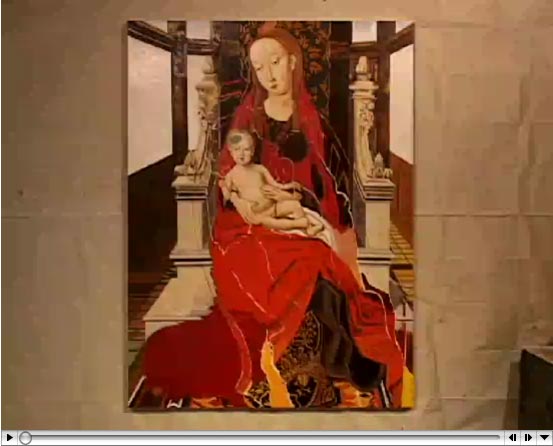
The career long intention for each painting I make is that it mimic nature by being fractal. The aim is that the painting be equally captivating whether viewed from across the room or a few inches from its surface.
So, this latest episode of edited sessions, accounted for here on digital video (QT 1.9 MB ), charts several weeks’ worth of painting with a brush whose diameter is no bigger than this letter o. The close focus attained, now it’s on to making things work from across the room. Stay tuned for the thrilling finale.
To see the canvas’s preceding videos, follow the appropriate link to the first, second or third installment.
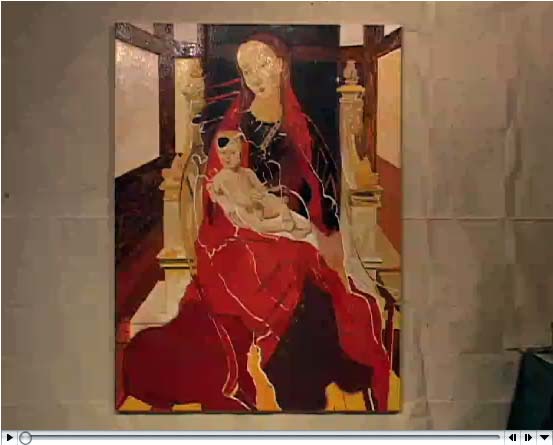
The third stop-action video installment of the in-process canvas is currently available for viewing (QT 3.2 MB).
In this episode, the entire canvas gets the once-over (at least once), focussing the image further as the work moves toward its intended refinement.
The first installment tracks the painting from blank canvas to basic allocation of surface real estate. The second installment documents the underpainting in preparation for subsequent glazes.
Sometimes the process of painting is subtle and incremental. Sometimes it’s a series of tectonic upheavals. For a literal instance of such tectonic rearrangement, check out this article about the new ocean emerging on the horn of Africa at breakneck speed, geologically speaking.
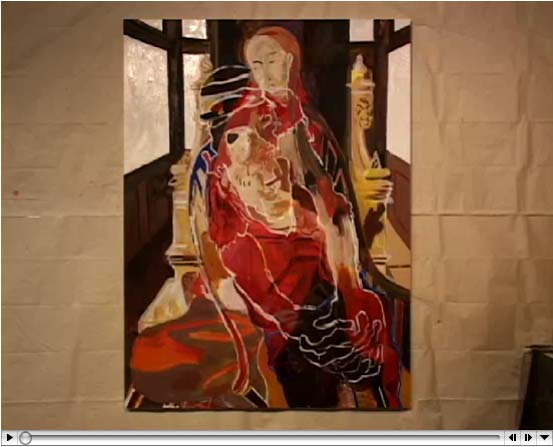
Click here to see the second DV installment of the current canvas. It represents about two week's worth of painting. (QT 2.7 MB)
To see how I arrived at this place, click here for the preceding video.
Hey, anyone out there know how I can eliminate the glare still showing on this oil slick surface? I've configured the lighting in every way possible. Suggestions?
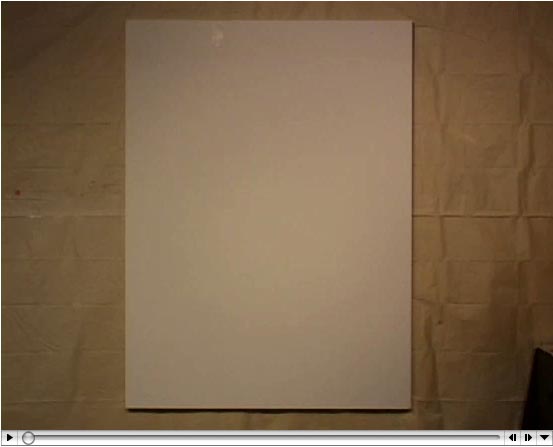
The maiden DV installment plotting the current canvas's journey is loaded onto the server and ready for viewing! The ultimate length and course of this adventure is yet unknown. But you can see the launch - via Quicktime - by clicking here. (4.4 MB)
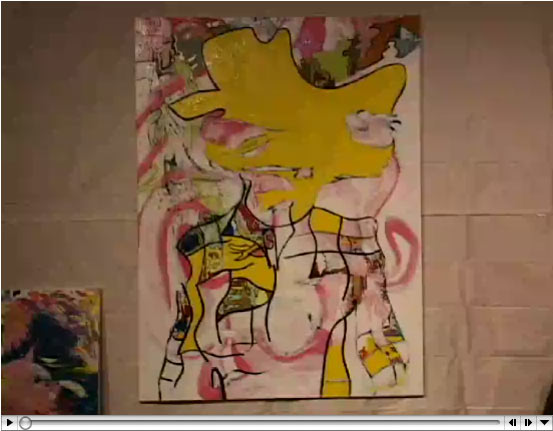
Continuing the process video... click here for the third installment of the current canvas as it nears completion. (Quicktime 4.9MB)
Roundabout halfway through this video segment, you’ll notice the shift to much smaller brushes and painting going on in a far more detailed manner than anything prior. This shift addresses my fascination with a compelling and fundamental painting convention.
One decision a painter makes is the range of brush size he or she is going to use. This decision, in conjunction with the brush sizes’ proportional relationship to the size of the canvas, determines the detail or focus each canvas offers the human eye.
As a thought experiment, consider Vermeer and de Kooning exchanging their brushes while everything else about their work remains constant.
The eye, of course, can focus across scales, perceiving one moment in a gestalt manner, scrutinizing the smallest details in the next, conflating one with the other.
One of my long-term fascinations has been to create paintings that represent this aspect of our perception of the world.
To view the first and second installments of the canvas’s development click here and here, respectively.
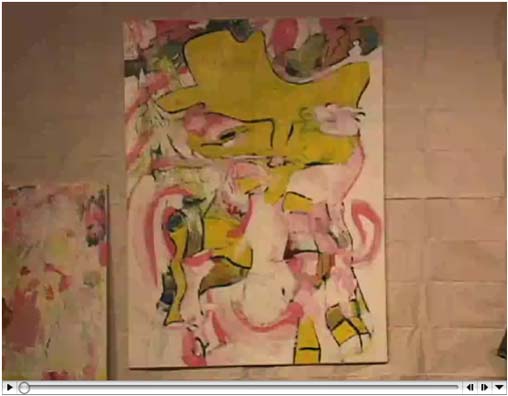
Picking up where we left off . . . click here for the second installment (DV mins. 1:07 - 2:04) of the canvas I'm currently working on.
To see the canvas go from :00 - 1:06 mins., click here. The Quicktime videos are 5.0 MB and 5.8 MB, respectively.
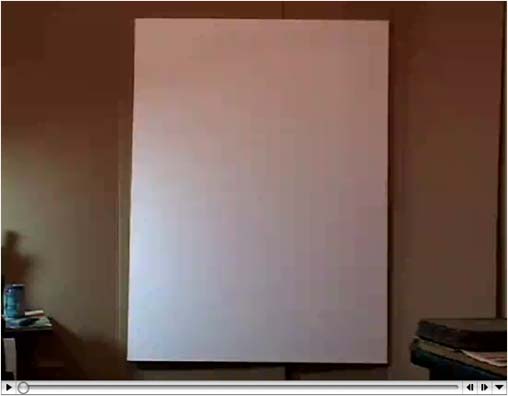
To see two week's worth of process on the current (still very active) canvas click here. Quicktime 5.8 MB
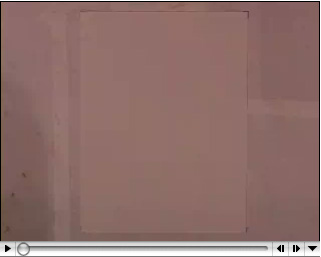
Maybe process is the object.
Click here to launch video. (Quicktime 1.9 mb)